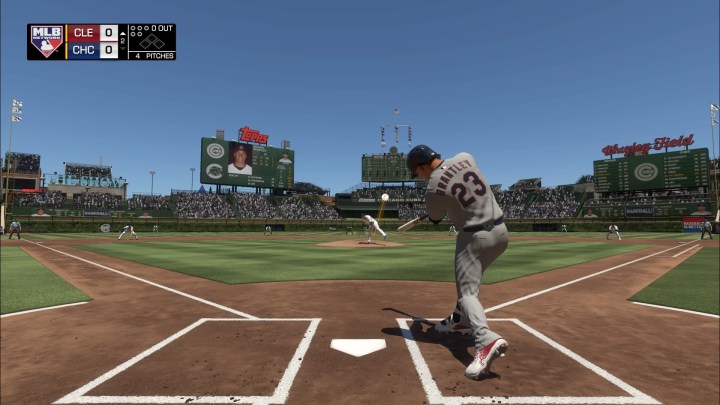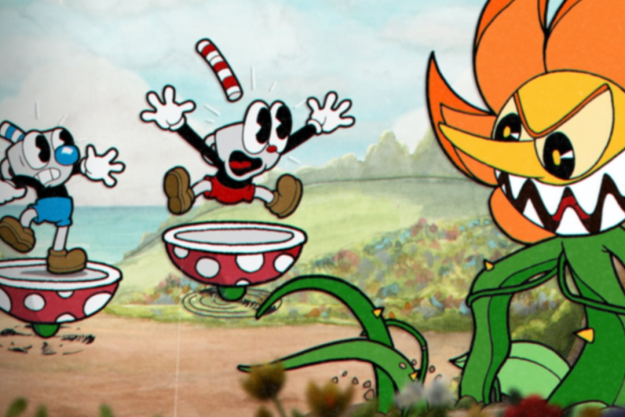
If you’re looking to hang some serious numbers on the scoreboard, here’s what you should keep in mind.
Putting bat to ball
In order to score some runs, you will have to hit the ball. Since baseball is a game of reaction time and reflexes, there’s no better teaching mechanism than stepping into the box and swinging away. Still, if you find yourself striking out a lot, you may want to take a step back and reevaluate your strategy.
- Watch the windup: Each pitcher in The Show has a unique pitching motion. Some motions are elongated, some are abrupt, and many are in-between. Keep your eyes on the pitcher’s throwing hand to see the point of release. By watching the ball from the moment it leaves the pitcher’s hand, you’ll have a better chance of tracking it as it pummels towards the plate. This becomes even more important when playing in a match with one of the pitch guessing sensors on such as PCI. Here, you’ll have to move the cursor towards where the pitch crosses the plate to make solid contact.
- Check pitches: Each pitcher has up to five different pitches, from four-seam fastballs to curveballs to changeups to sliders, and more. Depending on your settings, you can check the opposing player’s list of pitches by pressing R2. Now, it’s hard to guess what pitch your opponent will throw, but knowing which types of pitches are possible certainly doesn’t hurt your chances.
One swing to rule them all

You have three different swing options at the plate: Normal, contact, and power. How you use these swings is important, but not for the reasons you may think. Out of those three, you’re best served using the normal swing 90 percent of the time. The normal swing is a jack-of-all-trades. You can hit screeching liners, high smacks in the gap, and dingers that wind up in the back row of the bleachers.
This isn’t to say that you should avoid using contact and power altogether, but you’ll probably fare better if you save them for special situations.
- Contact: The contact swing is great when you are down in the count and you absolutely need to put the ball into play to advance runners on base. If you have a poor batter at the plate — such as your pitcher — the contact swing is your best bet.
- Power: Certainly the most enticing of the three, the power swing is the hardest to execute successfully, and using it can lead to a fair number of strikeouts and walks. If you are up in the count, and have a home run hitter — usually your third, fourth, and/or fifth hitter in the lineup — at the plate, the power swing can be useful. In our experience, pitches lower in the strike zone are ideal for the power swing.
Left, center, right — use the whole field

After making contact, the most important aspect of batting is making a conscious effort to control where the ball goes on the field. The Show 17 helps you with its directional arrows which can be pointed at three different heights across right, left, or center field. While using the arrows can go a long way towards steering the ball, you also have to do some of the work yourself. By timing your swing properly, you can start to gain control of ball placement.
- Right handers: Naturally, the ball pulls to left field; to send it up the middle, you’ll have to sit on the pitch for a moment longer before swinging. To hit it the opposite way, you have to swing even later, almost to the point where you feel as if you’ll whiff. Keep in mind that hitting the ball the opposite way is easiest when the pitch is over the outer half of the plate.
- Left handers: With a tendency to pull the ball to right field, you’ll have to wait on the pitch to hit it up the middle, and delay your swing even longer to knock it the opposite way into left. Like with right handers, pushing the ball into opposite field is easiest when the ball is on the outer half of the plate.
Diversifying where you hit the ball helps keep your opponent on edge. Since fielders tend to position themselves based on whether a right or left hander is at the plate, using the opposite side of the field when given the right opportunity can often create seams in the defense that otherwise wouldn’t be there.
Lefty versus lefty, righty versus righty
Generally speaking, batters have more success against opposite handed pitchers. Righties do better against lefties, and vice versa. Some of this has to do with the fact that you have a better read on the ball from standing on the opposite side of the plate of where the pitch starts, but it’s also because it’s easier to hit pitches that curve and drop towards the batter.
When batting against a same-handed pitches, breaking pitches like curveballs and sliders will break down and away from you. It’s harder to hit an inside pitch against a same-handed pitcher, so that’s where a quality opponent will try and put it. Since they don’t have much room for error, wait for a pitch to hang over the plate or the outside edge to take your cut.
Bunts

Bunting isn’t as exciting as cranking one over the Green Monster at Fenway Park, but this frequently underutilized skill is an important one to master. While bunting shouldn’t be used excessively, if you have a runner on third and fewer than two outs, bunting is a high percentage way to tack on a run.
- Sacrifice bunt: If you want to advance a man on base and have an out or two to spare, the sacrifice bunt is an effective play. To lay down a sacrifice bunt, simply press and hold triangle before or during the pitcher’s windup. As long as the pitch is near the zone, it’s not hard to make contact, allowing a runner to reach second, third, or home in the process. Bunting is also a good way to avoid a double play if you have a ground ball hitter at the plate.
- Drag bunt: Harder to pull off than the sacrifice, the drag bunt gives you the best opportunity to reach first safely. The drag bunt is accomplished by pressing triangle when the ball is on its way to the plate, creating a more sweeping motion unlike the stagnant sacrifice bunt. It’s easiest to execute with a left handed, speedy batter. You can either bunt it down the first base line to force the first baseman to come in to make the play, or aim it down the third base line to force the pitcher or third baseman to make a tough play on the ball. If done right, you can get a single off of a drag bunt, in addition to advancing runners.
- Fake bunt: If you show your bunt too early, your opponent might purposely pitch out of the strike zone to eliminate your chances of performing a bunt, and notch a strike. In general, make sure to pull back if the pitch looks far out of the zone, but you can also make your opponent’s strategy backfire by pretending to bunt, thus racking up balls that lead to walks.
More Tips and tricks
- Check out player stats: Each player has a stat wheel that lays out strengths and weaknesses. From contact and power versus left and right handed pitchers, to plate vision, each batter is unique. Use stats to your advantage. High power ratings — greater than 50 — align with home run capabilities. Contact stats let you know how easy it is for each player to hit the baseball. Plate vision gives you an idea of how well each a player sniffs out pitches and turns them into opportunities.
- Take walks when you can: Chopping away at ill-advised pitches is never a good strategy. Walks are just as good as hits, so be patient.
- Wear the pitcher down: As your opponent’s pitch count rises, his pitches will begin to lose some velocity as his energy drains. High pitch count at-bats, even if they end in an out, are almost always positive trips to the plate. To make the at-bat count, you can attempt to deliberately foul balls out of play. This takes some practice, but if you get behind the pitch, and swing late, you should be able to hit foul balls with precision.
Editors' Recommendations
- Best PlayStation Plus Deals: Save on Essential, Plus and Premium
- The best video game remakes of all time
- The best 17-inch laptop bags and backpacks for 2023
- MLB The Show 23 returns to Xbox, PlayStation, and Nintendo Switch this March
- The best multiplayer games on PS4


